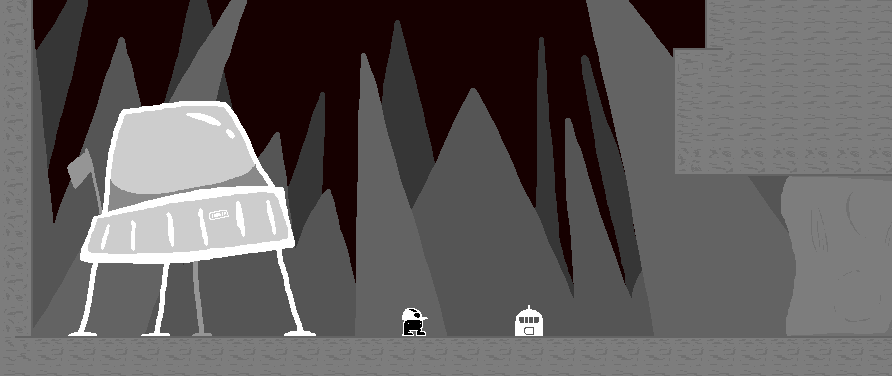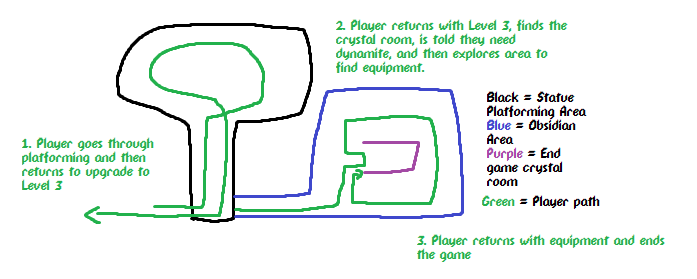
Lone Miner
Project Type: Academic
Time: July 2024 (One Month)
Made Using: GameMaker
Role: Solo Developer
A 2D Platformer inspired by Metroid and Minecraft
Key Lessons Learned:
Player Engagement - Simple collectible hunting is not enough to engage players through even a five-minute experience.
Lone Miner was my last project at DigiPen Institute of Technology for my final Design Capstone class; essentially a project class for Game Designers.
Originally drafted out as an idea for a personal project, I thought about using Lone Miner for this class since it seemed like it had good potential, especially when it was one of the more detailed of the ideas I’ve drafted. Besides, it seemed low-scope enough for me to pitch as a “Game Jam” game. Lone Miner ended up becoming more than a “Game Jam” game.
How Lone Miner had changed from its very first build to the build I submitted at the end of the semester.
In Lone Miner, you play as an unnamed employee of a space mining corporation sent to the unexplored moon, Sardon TC-0-3, to investigate an unknown energy signature. Alongside your scouting mission, you are tasked with mining any alien ore and flora that could be found on the moon.
The Caves of Lone Miner,
or Why Should I Care About These Rocks I’m Mining?
I was interested in this project because it let me practice with making (mostly) non-linear and open-ended spaces. It was inspired by Metroid and Hollow Knight where I wanted players to explore the space at their own leisure.
Screenshots showcasing the various room layouts and tile sets present in the game (Left click on an image to look closer!)
An sketch of an iteration of the Magma Area of the game.
The final room was blocked off initially by a single Red Ore and testers were ending the game without even seeing the Magma Area. Thus, I came up with this side quest to force players to go there and the room layout already looped to let players come back to the final room easily and end the game!
Reflecting on this also made me ask why players were so fond of exploring caves in Minecraft and Metroid too.
In Minecraft, exploring caves was a feedback loop in of itself where you went in, fended off the monsters there so you don’t die, and usually came back with a haul of loot that had a variety of uses beyond letting you progress.
In Metroid, finding new power-ups was rewarding because they let you progress by opening different locks and you got a cool new toy to blast enemies with.
Lone Miner initially didn’t give players a similar high either of these games did. Sure, finding ore upgraded your pickaxe, but your pickaxe just mined higher level ore. So what? In the final version of the game, you got a sweet drill, double jumps, more story bits, and you got past those pesky platforming challenges as you progressed and I wish I leaned more into that.
I initially designed the rooms to be atmospheric. I wanted players to be intrigued and explore the space in the hopes of finding secrets to mine more ore and find collectibles. I also created six unique tile sets to group the rooms under to give players a sense of progression and help create a mental map of the game.
However it became clear with testing and mentoring that this was not enough to motivate players. Looking back on it, it was a mistake to let this initial vision of ambience fester without playtesting. Just giving players an intentionally empty play space with collectibles they don’t understand beyond “the game told me to find these” doesn’t give enough of a push to get players through even a five-minute experience.
This is why I feel the latter part of development in Lone Miner after I began communicating with Dan Felder as a mentor was where the game started to become engaging for players and I became more invested with developing the game.
Dan influenced me to implement ideas such as:
Story Notes - to tease players about the game’s story and motivate them to find more to put together and interpret a story
Platforming Challenges - to engage players more with the space instead of just mind-numbing ambience and bare-bones secrets
More Collectibles - Such as the God Idols in the Temple Area and the Dynamite & Plunger in the Magma Area so that players are searching for more things beyond just the ores
Every unique tile set made for Lone Miner, each one hand-drawn in GameMaker’s built-in sprite editor. Each one was made with a unique shape and color.
What Now?
Although it is finished, there are plenty of things I would like to do with the project if I picked it up again or made a sequel.
One of the first things I would do with the game is shift the room designs’ focus to platforming and put the story at the forefront — place more unique collectibles in the same nature as the God Idols and provide the player with more upgrades. The platforming and story provided stronger motivation for players rather than just simple exploration.
With that said, I’m really happy that I got in touch with Dan Felder because Lone Miner would have just been a very forgettable game without his insight and the feedback of my testers.
Another addition to gameplay that I made with players in mind: giving them a big drill. I teased players with an ore they couldn’t break at the start and testers loved getting revenge with their new toy. It was also a great showcase of the drill’s ability to be continuously used and I tried to add more moments like that throughout the game.
